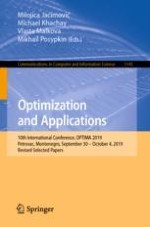2020 | Buch
Optimization and Applications
10th International Conference, OPTIMA 2019, Petrovac, Montenegro, September 30 – October 4, 2019, Revised Selected Papers
herausgegeben von: Milojica Jaćimović, Prof. Michael Khachay, Vlasta Malkova, Dr. Mikhail Posypkin
Verlag: Springer International Publishing
Buchreihe : Communications in Computer and Information Science
